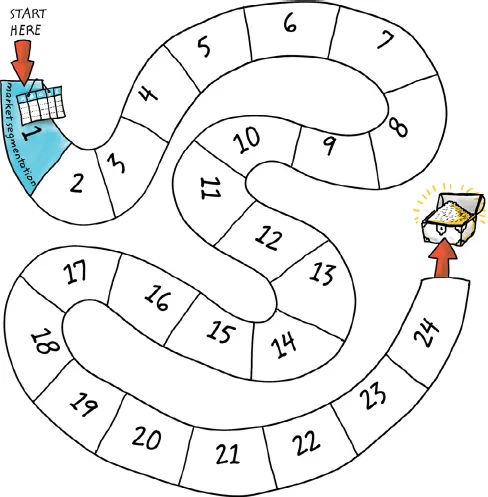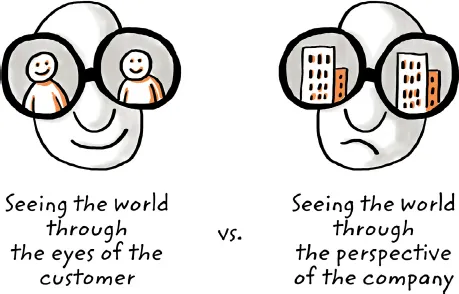![]()
Step 1
Market Segmentation
IN THIS STEP, YOU WILL:
- Brainstorm a wide array of potential customers and markets for your business.
- Narrow your list down to your top 6–12 markets.
- Gather primary market research on your top 6–12 markets.
Once you have completed Step 0, Getting Started, you should have an idea or technology that answers the question, “Is this something the world could benefit from, and is it something I do well and would love to do for an extended period?” You should also have a team of co-founders. (Throughout the 24 Steps, I will use “you” to refer collectively to your team.)
Now you will begin the 24 Steps by taking that idea or technology and brainstorming a wide array of potential customers who might be interested in some application of it. Then you will choose 6–12 top opportunities and do in-depth primary market research, where you directly interview potential customers to learn more about them.
THE SINGLE NECESSARY AND SUFFICIENT CONDITION FOR A BUSINESS
Regardless of your business, you must ask yourself, “What is the single necessary and sufficient condition for a business?” It is not a product, a technology, a customer need, a business plan, a vision, a strong team, a CEO, money, investors, competitive advantage, or company values. While all those are great things for a business to have, none of them is the right answer.
The single necessary and sufficient condition for a business is a paying customer.
The day someone pays you money for your product or service, you have a business, and not a day before. This simple truth will keep you focused on what is important. You cannot define a business as a product, because if nobody buys your product, you simply do not have a business. The marketplace is the final arbiter of success.
Now, just because you have a paying customer does not mean you have a good business. In order to have a good, sustainable business, you will need to gain enough customers paying enough money within a relatively short period of time so you do not run out of capital, but instead, become profitable. And as a startup, you have few resources, so every action you take must be hyper-efficient.
Therefore, you will not start by building a product or hiring developers or recruiting salespeople. Instead, you will take a customer-driven approach by finding an unmet need and building your business around it.
CREATE A NEW MARKET THAT YOU WILL DOMINATE
Creating an innovative product where no market currently exists is essential to the success of a startup. By creating a new market, you will have a very high, if not dominant, market share that you can use as a basis for future expansion. Being a “me-too” company in an existing market is a more difficult proposition given your limited resources.
To create this company in a newly defined market space, you will focus on a target customer. A target customer is a group of potential customers who share many characteristics and who would all have similar reasons to buy a particular product. Focus is the most important skill for an entrepreneur, and as you will find throughout these steps, it is difficult to focus too much. You must work hard to identify and understand customers through primary market research, because relying on “educated assumptions” or third-party analysis is guesswork when you are creating new markets.
Once you have established a foothold within that target group, meaning that you’ve provided that group with a substantially superior product and they are paying you for it, you will have enough resources to expand to an adjacent market. In an adjacent market, some customer characteristics will be the same as your primary market, but there will be enough differences to require tailoring your strategy appropriately. That process is covered in Steps 14 and 24.
WHEN “PAYING CUSTOMERS” LEAD YOU ASTRAY
While paying customers ultimately determine whether your product is successful, there are two common pitfalls you may encounter if you do not focus on creating a new market.
The first is “selling to everyone,” which is the idea that you, as a fledgling startup with little to no resources, can make products that fit the needs of anyone you run across.
Let’s say you have invented a new polymer that waterproofs fabric better than anything on the market. You first hear from your friend Sally, who read in the newspaper that camping equipment is a lucrative market, so she suggests you sell tents. Your cousin Joe chimes in; he wants waterproof underwear. A neighbor thinks that easy-to-clean stuffed animals for children would be just lovely.
To design and execute any of these products will take time and resources. If you start production on one product, and find there aren’t enough customers to make your venture profitable, you almost certainly will not have the resources to keep making products until you find a profitable market.
The second common pitfall is “The China Syndrome,” also known to my students as “fun with spreadsheets.” Rather than create a new market, the thinking goes, one could choose a huge existing market, get a fraction of the market share, and reap the rewards. After all, if you could get even a tenth of a percent of the toothbrush market in China (population 1.3 billion), wouldn’t you make a lot of money?
The logic would go something like this: “The Internet says China has over 1.3 billion people. If they all have teeth, the market size is 1.3 billion customers. I’ll build a toothbrush for the Chinese market, and maybe we’ll get 0.1 percent market share in the first year. If each person buys three toothbrushes a year, we could sell 3.9 million toothbrushes per year, and if we sell them for $1 each, we have $3.9 million in sales the first year, with lots of room to grow.”
I call such a high-level market analysis “fun with spreadsheets,” because you have not demonstrated in a compelling manner why people would buy your product or why your market share would increase over time. You also have not validated any of your assumptions by learning directly from customers—you probably haven’t even been to China. After all, if entrepreneurship were this easy, wouldn’t everyone sell toothbrushes to China?
Big companies with lots of resources can afford to work hard to gain incremental market share, but entrepreneurs don’t have the luxury of resources. Don’t get ensnared by “The China Syndrome.”
Take your resources and apply them to a narrow, carefully defined new market that you can dominate.
COMPLEX PAYING CUSTOMERS: PRIMARY VERSUS SECONDARY CUSTOMERS AND TWO-SIDED MARKETS
Thus far, I have used “customer” to refer to the entity—such as a household, organization, or individual—who pays for, acquires, and uses your product. Within the broad definition of a customer, there is the end user, who ultimately uses your product, and the economic buyer, who makes the final decision about whether to acquire the product. The end user and economic buyer can be the same person, depending on the situation. (I describe the various role...


